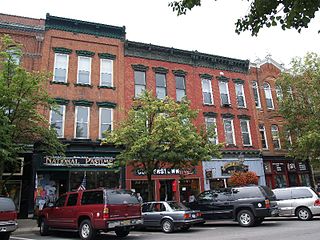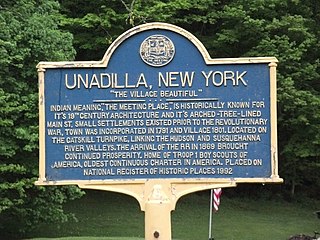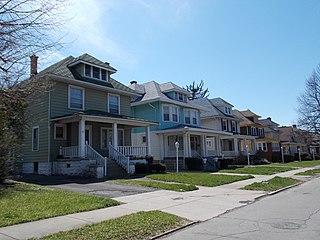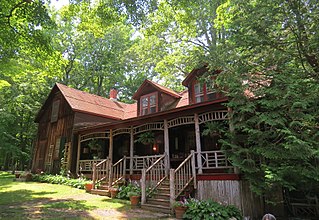
Cooperstown is a village in and county seat of Otsego County, New York, United States. Most of the village lies within the town of Otsego, but some of the eastern part is in the town of Middlefield. Located at the foot of Otsego Lake in the Central New York Region, Cooperstown is approximately 60 miles southwest of Albany, 67 mi (108 km) southeast of Syracuse and 145 mi (233 km) northwest of New York City. The population of the village was 1,852 as of the 2010 census.

The Cooperstown Historic District is a national historic district in Cooperstown, Otsego County, New York, that was listed on the National Register of Historic Places in 1980. It encompasses 232 contributing properties: 226 contributing buildings, 1 contributing site, 3 contributing structures, and 2 contributing objects. Among the contributing properties is the village's post office, which is individually listed on the National Register.

There are 73 properties listed on the National Register of Historic Places in Albany, New York, United States. Six are additionally designated as National Historic Landmarks (NHLs), the most of any city in the state after New York City. Another 14 are historic districts, for which 20 of the listings are also contributing properties. Two properties, both buildings, that had been listed in the past but have since been demolished have been delisted; one building that is also no longer extant remains listed.

Zion Episcopal Church Complex and Harmony Cemetery is a national historic district comprising a historic Episcopal church complex and cemetery located at Morris in Otsego County, New York. The complex consists of the church, rectory (1893), and parish house (1901). The church was built in 1818 and is a stone building in the early English Gothic Revival style. It features a steeply sloping gable roof and a central projecting bell tower with a belfry with a balustrade. The Harmony Cemetery has burials dating from about 1800 to 1937.

East Main Street Historic District is a national historic district located at Richfield Springs in Otsego County, New York. It encompasses 57 contributing buildings, one contributing site, eight contributing structures, and one contributing object. The body of the district includes 33 historic residences, two historic boarding houses, a theatre, post office, a former hotel, and a church. Spring Park includes a contributing post clock (1918), set of semi-circular limestone steps, bandstand (1904), and cobblestone fountain (1931). Located within the district boundaries is the U.S. Post Office building.

West Main Street–West James Street Historic District is a national historic district located at Richfield Springs in Otsego County, New York. It encompasses 58 contributing buildings and three eight contributing structures. The body of the district includes 21 businesses and 29 historic residences, a school, library, and a church complex. The district incorporates the historic institutional and commercial core of the village and a significant residential neighborhood.
Fly Creek Historic District is a national historic district located at Fly Creek in Otsego County, New York.

Unadilla Village Historic District is a national historic district located at Unadilla in Otsego County, New York. It encompasses 145 contributing buildings, two contributing sites, one contributing structure, and three contributing objects. the majority of the buildings are residential, with four churches, 11 commercial buildings, six institutional and/or public buildings, one historic cemetery, three monuments, and a limestone railroad underpass.

Roseboom Historic District is a national historic district located at Roseboom in Otsego County, New York. It encompasses 73 contributing buildings and two contributing structures. The district includes two churches, a cemetery associated with the former Baptist church, a general store, two early 20th century industrial buildings, a schoolhouse, a grange hall, and dwellings with associated agricultural, industrial, and commercial outbuildings. The bulk of these properties were developed between 1840 and 1900.

Oneonta Downtown Historic District is a national historic district located at Oneonta in Otsego County, New York. It encompasses 64 contributing buildings and one contributing site. It encompasses the city's intact commercial and civic core and includes commercial buildings, six churches, the city's historic civil buildings, a few industrial buildings, and a small park. The district includes several separately listed buildings: the Masonic Temple, Old Post Office, Municipal Building, Ford Block, and Oneonta Theatre.

Canajoharie Historic District is a national historic district located at Canajoharie in Montgomery County, New York. It encompasses 836 contributing buildings, 4 contributing sites, 11 contributing structures, and 19 contributing objects in the central business district and surrounding residential sections of the village of Canajoharie. It developed between about 1750 and 1959, and includes notable examples of Greek Revival, Italianate, Queen Anne, Colonial Revival, Tudor Revival, and Bungalow / American Craftsman style architecture. Located in the district are the separately listed Bragdon-Lipe House, the Van Alstyne House, the West Hill School, and the United States Post Office. Other notable contributing resources include the Village Hall (1941), Canajoharie Creamery, Beech-Nut No. 1 Plant, Beech-Nut No. 2 Plant, Reformed church (1842), Episcopal Church of the Good Shepherd (1874), St. Mark's Lutheran Church (1868), Saints Peter and Paul Roman Catholic church, Sayles Building (1868), and the Arkell Foundation complex.

Hamlin Park Historic District is a national historic district and neighborhood located at Buffalo in Erie County, New York. The district encompasses 1,368 contributing buildings, 3 contributing sites, and 6 contributing structures in a predominantly residential section of Buffalo. The district includes a variety of residential buildings built primarily between about 1895 and 1930, and later improved through Model Cities Program grants between 1966 and 1975. It includes a variety of pattern book houses in popular architectural styles of the late-19th and early-20th century, with some interspersed Bungalow / American Craftsman style dwellings. Located in the district are the separately listed Robert T. Coles House and Studio and Stone Farmhouse. Other notable buildings include the Lutheran Church Home (1906), the former Second United Presbyterian Church (1920), and the former St. Francis DeSales Roman Catholic Church (1926).

Market Square Historic District is a national historic district located in the Black Rock neighborhood of Buffalo in Erie County, New York. The district encompasses 15 contributing buildings and 1 contributing site in a mixed residential and commercial section of Buffalo. The district developed between about 1830 and 1912, and includes a buildings in a variety of architectural styles including Federal, Gothic Revival, Italianate, Queen Anne, Romanesque Revival, and Bungalow / American Craftsman. Located in the district is the separately listed St. Francis Xavier Roman Catholic Parish Complex. Other notable contributing resources include the Market Square (1830), Black Rock Savings and Loan (1870-1910), Firehouse Engine #15 (1912), Smith House and Tavern, St. John's Church (1894), and Howell House and Store.

South Wedge Historic District is a national historic district and neighborhood located in southeast Rochester, Monroe County, New York. The district encompasses 434 contributing buildings in a predominantly residential section of Rochester. The district includes a variety of residential buildings built primarily between the 1840s and 1920s, and consists mainly of two-story detached houses built as single-family or two-family residences. The architecture is primarily vernacular with a few examples of high-style Italianate and Queen Anne style residences. Located in the district are the separately listed Saint Andrew's Episcopal Church and Nazareth House. Other notable buildings include the St. Boniface Church complex, the former School 13, the former School 28, and former Engine Company No. 8.

Hartwick Historic District is a national historic district located at Hartwick in Otsego County, New York. The district encompasses 149 contributing buildings and 1 contributing site in the hamlet of Hartwick. The buildings date from about 1800 through the 1960s, and include representative examples of popular architectural styles. Notable buildings include the Christian Church, Methodist Church (1839), First Baptist Church (1856), Hartwick Coal and Feed Co. (1901), and former Harwick High School (1921).

East Hill Historic District is a national historic district located at Springville in Erie County, New York. The district encompasses 59 contributing buildings and 2 contributing objects in the original residential district of the village of Springville. The district includes a variety of residential buildings built between about 1835 and 1935. It includes notable examples of Greek Revival, Italianate, Queen Anne, Colonial Revival, and Bungalow / American Craftsman style architecture. Notable buildings include the George E. Crandall House / Warner Museum, Frank O. Smith House, C.J. Shuttleworth House, Morris Hall House (1892), and Inez Wiggins House.

Chili–West Historic District is a national historic district located at Rochester, Monroe County, New York. The district encompasses 508 contributing buildings in a predominantly residential section of Rochester. The district developed between about 1874 and 1935, and includes buildings in a variety of architectural styles including Queen Anne, Colonial Revival, Gothic Revival, and Tudor Revival, Mission Revival, and Bungalow / American Craftsman. The dwellings reflect designs directed toward a middle-class and working class clientele in a newly developing area of Rochester's Nineteenth Ward. Located in the district is the former St. Augustine Roman Catholic Church complex.

Holley Village Historic District is a national historic district located at Holley, Orleans County, New York. The district encompasses 40 contributing buildings, 1 contributing site, and 1 contributing object in the central business district of the village of Holley. The district developed between about 1822 and 1952, and includes buildings in a variety of architectural styles including Greek Revival, Italianate, Queen Anne, Beaux Arts, and Late Gothic Revival. Notable contributing resources include the Public Square and Salisbury Fountain (1914), First Presbyterian Church, White-Alis Building, Village Building, Rutland Block/Lockwood Building/Community Library (1896), Odd Fellows Hall (1890), Downs Residence, St. Mary's Roman Catholic Church (1904-1905), Downs Hotel/Hotel Holley designed by Andrew Jackson Warner, Village Building and Holley Standard, First Methodist Episcopal Church (1868-1869), and the Holley High School (1930-1931).

Ligonier Point Historic District is a national historic district located at Willsboro, Essex County, New York. The district encompasses 8 contributing buildings, 16 contributing sites, 7 contributing structures, and 3 contributing objects related to stone quarrying, boat building, and farming by the Clark family during the 19th century. They include the Clark Quarry and Farm, Scragwood, and Old Elm or the Corrin Clark Farm Complex. The Clark Quarry is represented by the remains of the Quarry Village; the principal, second, and third quarries ; boatyard ; Yacht Narragansett ; and a boarding house. Scragwood, or the S.W. Clark Complex, includes a rustic dwelling built in stages between the 1830s and 1870s. Associated with Scragwood are the Cedar Lodge, Perennial Garden, smokehouse, summer house, and tankhouse. Old Elm was built in 1841, and is a two-story, five bay, limestone dwelling with a 1 1/2-story frame wing. Also on the Corrin Clark Farm Complex are the blacksmith shop, smokehouse, icehouse, privy, and fruit orchard. Chazy limestone quarried from the Clark Quarry was used in the construction of the Brooklyn Bridge and New York State Capitol.
Elmwood Historic District–East is a national historic district located at Buffalo, Erie County, New York. The district encompasses 2,405 contributing buildings, 31 contributing structures, and 14 contributing objects in the Elmwood Village neighborhood of Buffalo. It is bounded on the north by Delaware Park, Forest Lawn Cemetery, and the former Buffalo State Asylum, on the south by the Allentown Historic District, and on the west by the Elmwood Historic District–West. This predominantly residential district developed between about 1867 and 1965, and includes notable examples of Queen Anne, Shingle Style, Colonial Revival, Tudor Revival, and American Craftsman style architecture. The district contains one of the most intact collections of built resources from turn of the 20th century in the city of Buffalo and western New York State. Located in the district are 17 previously listed contributing resources including the Buffalo Seminary, Garret Club, James and Fanny How House, Edgar W. Howell House, Edwin M. and Emily S. Johnston House, Col. William Kelly House, Lafayette Avenue Presbyterian Church, Parke Apartments, and the Unitarian Universalist Church of Buffalo. Other notable building include the Frank Lloyd Wright designed William R. Heath House (1904-1905), Herbert H. Hewitt House, School 56 (1910-1911), the Harlow House, A. Conger Goodyear house, Alexander Main Curtiss House, Nardin Academy campus, and Coatsworth House (1897).





















